2020 has been a crazy ride for many reasons but that didn’t slow down our progress in major discoveries. Grab a cup of coffee or tea and check out 10 amazing astronomy discoveries in 2020 (in no particular order).
For those who just want the list here you go!
- Biggest cosmic explosion ever detected and left a huge dent in space
- Astronomers Discover the Universe Expansion May not be Uniform
- Scientists Discover that a Class of Stellar Explosions Produce Lithium in the Universe
- Scientists Discover a New Type of Matter Inside a Neutron Star
- New Evidence Suggest that Pluto was Once a Hot Planet
- Astronomers have found the Source of Life in the Universe
- Hayabusa2 Completes Asteroid Sample Mission | OSIRIS-REx Retrieves Sample from Asteroid | China’s Chang’e 5 mission Retrieves Sample from the Moon | UAE Launches First Mission to Mars
- Largest-ever 3D Map of the Universe Released by Scientists
- Astronomers Find Data that Suggest there is an Ingredient Missing from Current Dark Matter Theories
- Life Floating on the Clouds of Venus? We’re Closer to Finding Out if that’s True
Biggest cosmic explosion ever detected and left a huge dent in space
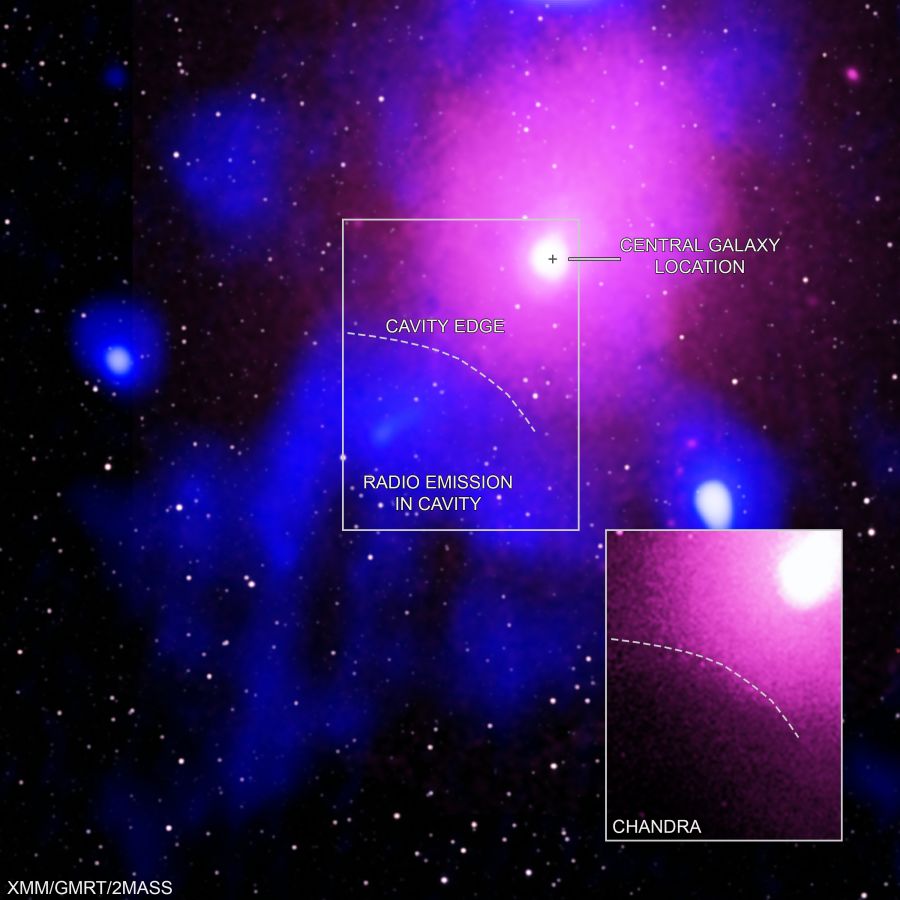
Credit: NASA/CXC/NRL/S.
Can you imagine the biggest explosion that ever happened in the universe? One so large that it leaves a dent larger than our own Milky Way! Well here’s the largest cosmic explosion astronomers have ever found thus far! Take a second look at the photo above. It has all the information of a cosmic explosion. It’s called the Ophiuchus Galaxy Cluster which is located a whopping 390 million light-years from Earth.
What is shown in that photo is a cluster of galaxies, which are the largest structures in the universe held together by gravity. However, there is a sinister supermassive black hole at the center of the Ophiuchus Galaxy Cluster. When Astronomers traced back the cosmic explosion to these jets that erupted out of this black hole what they found is a large cavity in the hot gas. That cavity is the “dent” the explosion left! You can see it in the photo where the traced line is. This points to the edge of the cavity.
This dent in the universe is so large that you could fit 15 of our very own Milky Way galaxy in it! You really can feel a sense of awe when you try to imagine something so immense.
Check out the rest of the story here.
Astronomers Discover the Universe Expansion May not be Uniform
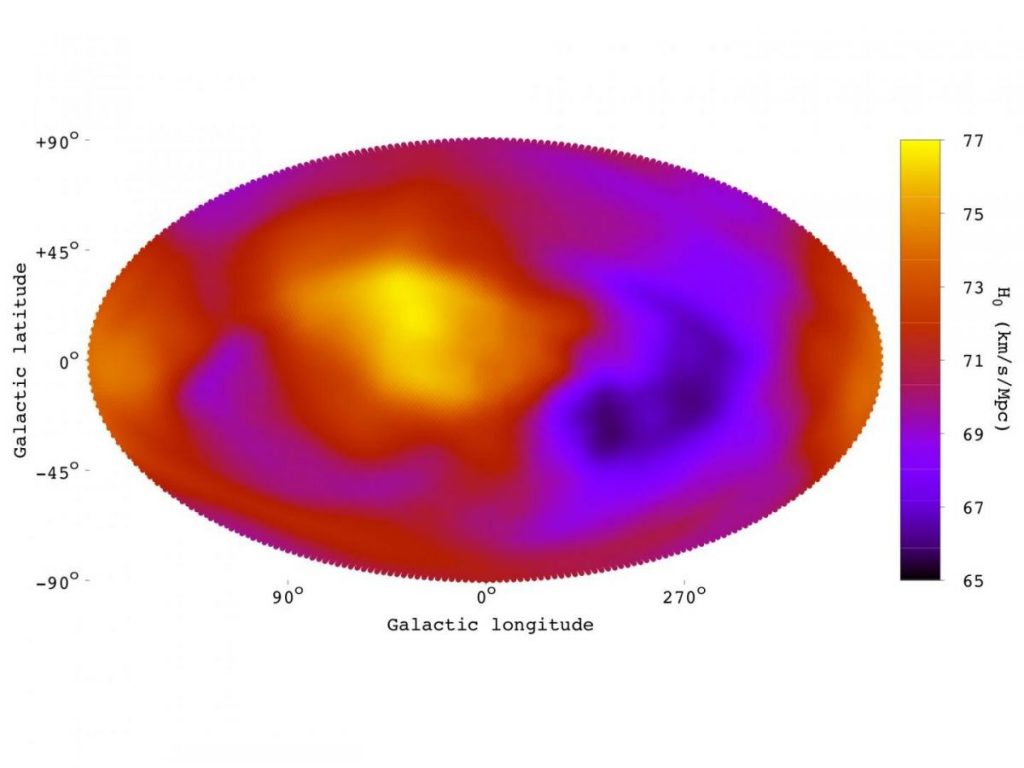
Our knowledge of the universe has evolved so much in the last 100 years alone. It was a profound discovery when it came to light that the universe was not static and it was actually expanding. Not only that, but that the expansion wasn’t slowing down but speeding up!
Over the next few decades, scientists started to realize there was something wrong with the expansion of the universe. It wasn’t that in all directions the universe was expanding at the same rate but at different rates! This idea is profound because it tells us that the basis of what cosmology is built on is completely different. What is this basis exactly? Let’s dig in a bit further.
When we think about the Big Bang theory of evolution it states that there are two assumptions. One is that the universe is homogenous and isotropic. In plain English, that means the universe is uniform (no preferred location) and it has no preferred direction when viewed on a large enough scale. These two assumptions combined is what we call the cosmological principle. This principle held up for a while as we looked at the universe in its infancy and saw it was both homogenous and isotropic.
This all changed when astronomer Konstantinos Migkas set a new way to test the theory of isotropy in the universe. They studied 800 galaxy clusters and the hypothesis is if the principle is true then these clusters should act in uniform across the sky. They looked at the temperature of these galaxy clusters through X-ray and then compared it to how bright they are in the sky. Each of them is located at the same distance and has the same temperature. However, when they compared it to their brightness in the sky they discovered it was wildly different between each cluster. That was the a-ha moment that led scientists to see if they were on to something big.
Check out the rest of the story here to learn what else they uncovered that changed our fundamental understanding of cosmology.
Scientists Discover that a Class of Stellar Explosions Produce Lithium in the Universe
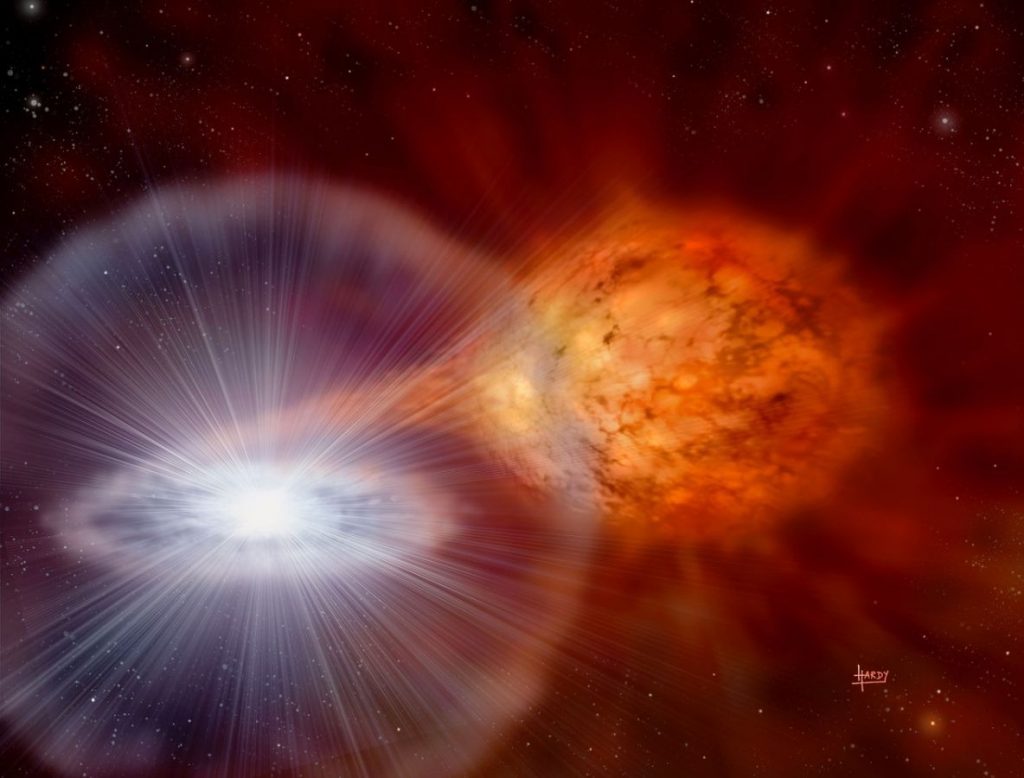
Credit: David A. Hardy
Scientists discovered when looking at a specific group of stars that explode, called classical novae, is the source of how most of the element lithium is produced. This is a big deal because understanding how these elements originate tells us more about our universe and our connection to it. You have used lithium every day whether you know it or not. Lithium is used in many batteries. That probably rings a bell if you ever see the packaging of AA batteries. Lithium is also used in the batteries that power our smartphones!
Interestingly, the same class of stars that go supernovae also produce most of the metals like iron for example. As we get a better understanding of what stars produce we also get a better understanding of where these resources exist.
For more information on this story check the rest here.
Scientists Discover a New Type of Matter Inside a Neutron Star

Jyrki Hokkanen, CSC – IT Center for Science
Astronomers discovered something intriguing about what lies in a neutron star. Researchers found that the neutron stars’ core is comprised of exotic quark matter. This is a first and unlike anything they’ve seen before. This can be a little tricky to wrap your head around it so let’s start a few steps back.
All the matter that is around us is made up of atoms. Those atoms have nuclei that have protons, neutrons and electrons. However, when you look at neutron stars, which is a result of giant stars that die in supernovas and their core collapses. You have a specific question in mind. The question is if these cores of these large neutron stars collapse further into some exotic matter and lose their nucleus.
As it turns out, the answer is yes. These stars do collapse into quark matter and lose their nucleus. The discovery opens up a whole new vertical on studying this exotic quark matter. It’s an impressive study and technique that these researchers were able to answer a 40-year-old question.
To learn more read the article here.
New Evidence Suggest that Pluto was Once a Hot Planet

What we know about Pluto in the last 5 years has completely changed in how we view these icy Kuiper belt objects. We thought Pluto would be this tiny icy rock floating on the outskirts of the solar system. Boy were we wrong! Pluto has one of the most dynamic surfaces than any other planet or moon in our solar system. It even has an atmosphere!
However, the new discoveries don’t stop there. Fast forward to 2020 where scientists discover that Pluto was once a hot planet with an ocean! Can you imagine that?
Scientists looked at the surface of Pluto to tell them this story. It went something like this. If Pluto started off as an icy rock then over billions of years the water would contract and you would see evidence of that on the surface today. However, looking at the data from the New Horizons mission to Pluto, astronomers see that the water did not contract but expanded! That means the only other scenario where that could happen is where Pluto was actually a hot planet with a liquid ocean and then over time became frozen.
This is another great discovery of 2020 and you can read the rest of the article here.
Astronomers have found the Source of Life in the Universe
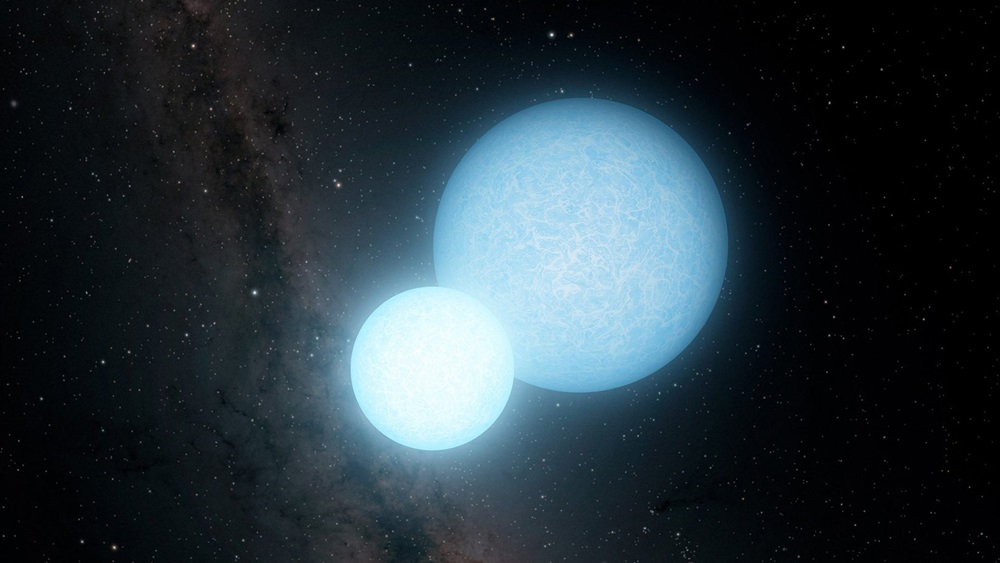
The universe is a vast place with billions and trillions of stars. These stars live their life and eventually kick the bucket and enter the last leg of their journey. Stars can end their life in many ways. Once all their fuel is burned off it can either go supernova and what is left behind is a dense neutron star. Another way is if the core is so dense that it turns into a black hole. However, stars that are around the size of our own Sun go a slightly different direction and turn into a red giant and eventually leaves a white dwarf.
Why is this important? Well, astronomers discovered that these white dwarfs are actually contributing more to the source of life in the universe than we once thought. In our own Milky Way, scientists noticed that the source of carbon is from none other than white dwarfs! Carbon is the fourth most abundant element in the universe. As it turns out carbon is also fundamental in the building blocks of life. Humans are carbon-based life-forms.
When you think about that carbon actually comes from stars that died and gave life to humans in a way – we really are made of star-stuff!
Check out the rest of this story here.
Hayabusa2 Completes Asteroid Sample Mission | OSIRIS-REx Retrieves Sample from Asteroid | China’s Chang’e 5 mission Retrieves Sample from the Moon | UAE Launches First Mission to Mars
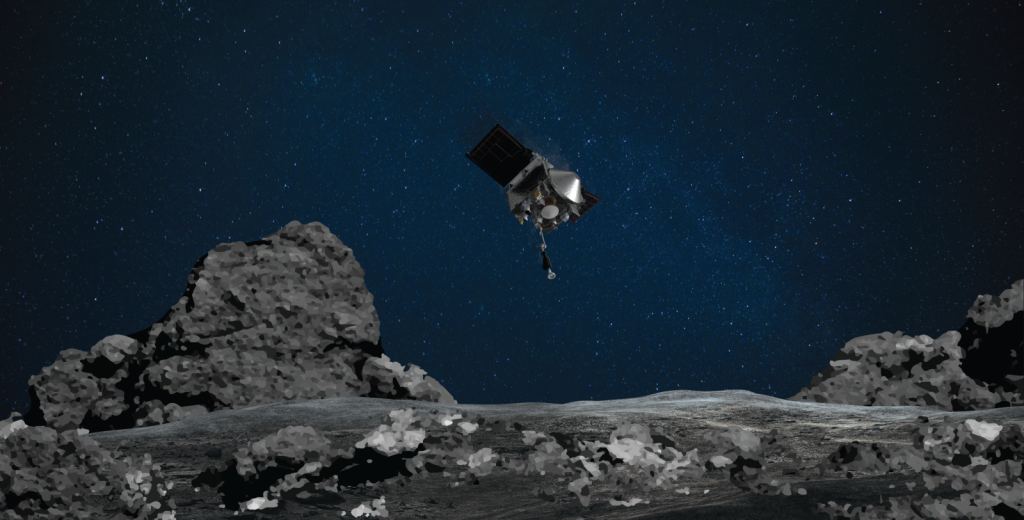
Credits: NASA/Goddard/University of Arizona
Here are four stories that revolve around solar system missions. Although 2020 was extremely hard on everyone on Earth we still had some amazing progress beyond.
Up first is Japan Aerospace Exploration Agency (JAXA) with Hayabusa2 mission to asteroid Ryugu. It is Japan’s first asteroid retrieval mission that launched in 2014 and touched down on the asteroid in February of 2019. When the capsule landed on Earth in December 2020 Japan’s goal was to get at least 0.1 grams sample from Ryugu. JAXA has commented that they have a “substantial amount” which is very exciting.
Read more about Hayabusa2’s touchdown to Earth here.
Next, we have the National Aeronautics and Space Administration (NASA) OSIRIS-REx mission to asteroid Bennu. This mission is an exciting one for NASA as it’s retrieving a sample from an asteroid that’s been around since the early solar system. This will give scientists a lot more insight into what our solar system was like back then. OSIRIS-REx will be returning back to Earth in 2023 – so mark your calendars! 🙂
To read more about this story check the article here.
China’s space agency is no slouch this year with many accomplishments. This one is specifically towards China’s Chang’e 5 mission to the Moon. China went to go retrieve Moon samples which haven’t been done since the ’70s! It was a 23-day mission and the sample is already in the hands of scientists. This is also part of China’s larger plan of exploring the Moon which ultimately will lead up to a mission to send astronauts to the Moon by 2030.
To learn more read this story here!
Our last but not least story is the United Arab Emirates launched their historic first mission to Mars. The spacecraft is called Hope and will arrive in a few months or February of 2021. It’ll help uncover the mysteries of why Mars lost its atmosphere. The mission is not one of the scientific objectives but also one of inspiring a generation of future scientists and engineers in the middle east.
To learn more about this story you can head on over here.
Largest-ever 3D Map of the Universe Released by Scientists
When we look at the data that we have on mapping and understanding the universe we have a lot of data on the ancient universe as well as the recent universe. However, there is a gap in the middle 11 billion years of the universe that we need. A project called extended Baryon Oscillation Spectroscopic Survey (eBOSS) which consists of 100 astrophysicists collaborating internationally on getting this data.
It took these scientists five years to put this unprecedented data together to paint a picture of this 11 billion year gap. The video above is a great explanation of the result of that work. It captures a whopping two million galaxies and quasars in the survey.
This is one of the biggest advancements in cosmology in the last decade and there is still so much in the data that is untapped.
To learn more about this exciting discovery read the rest of the story here.
Astronomers Find Data that Suggest there is an Ingredient Missing from Current Dark Matter Theories
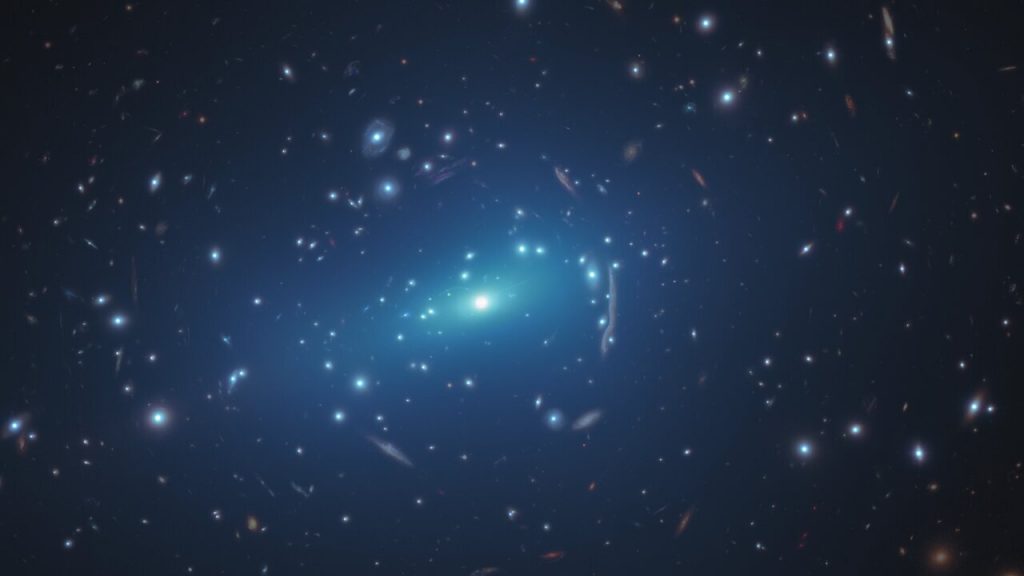
One of the biggest mysteries in the universe is how fast does the universe expand? Well, we did answer that question somewhat. Hubble’s constant is one of the most important discoveries that told us the rate of expansion of the universe. However, the problem is when scientists measured how fast galaxies were moving away from us that the data showed it was at different rates.
In fact, scientists discovered that some small-scale dark matter concentrations caused a lensing effect of 10x or more. That would mean it would throw off the data or we’d have to account for that great lensing effect as we study galaxies far away.
Dark matter is at the frontier of our knowledge of the universe. It accounts for about 27% of the universe. It’s the invisible “stuff” that holds galaxies together. When scientists calculated the dimensions and physics of a galaxy that they noticed something major is missing. That something major is dark matter.
Scientists continued to probe the question around dark matter and took observations of galaxies where the lensing effect occurs and signals there is an amount of dark matter as well as high resolution simulations. Together they started to see a fascinating comparison and connection. This doesn’t mean they’ve found the answer to dark matter but a much clearer path on the relationship.
There is still a lot more work to be done but scientists have made great progress in one of the largest questions in cosmology today.
To read more about this story check the rest here.
Life Floating on the Clouds of Venus? We’re Closer to Finding Out if that’s True
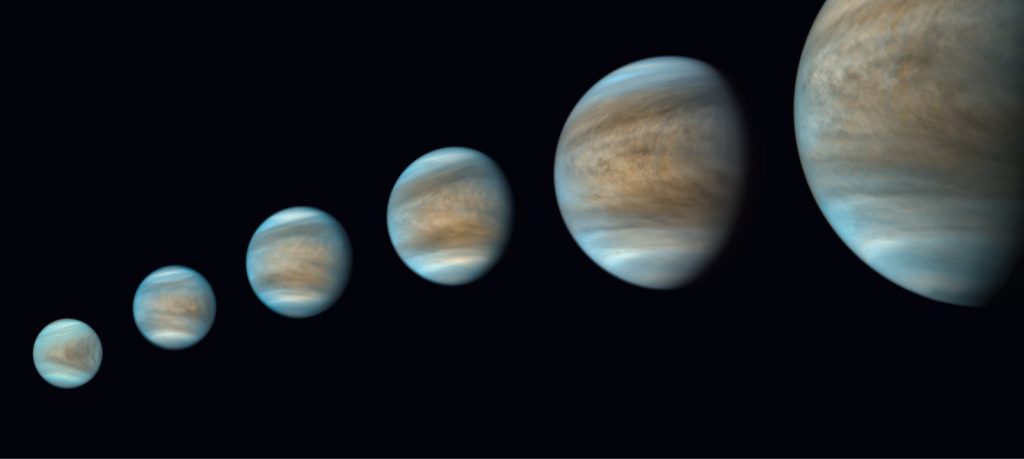
Venus is the hottest planet in our solar system. A place where it rains acid and temperatures are around 430 degrees C (800 degrees F). What are the odds that life could exist on the planet with such a hostile environment? Well, scientists discovered something peculiar that may suggest life could exist. Life in this context is really microbial and not intelligent life like animals.
What they found is a gas that exists in the atmosphere called phosphine that can’t be explained in how it got there other than a living organism. On Earth phosphine is associated with living things. Phosphine lives in a penguin’s gut or you could also find it in oxygen-poor environments like swamps.
The interesting thing about the upper atmosphere of Venus is that it’s a lot more livable than the surface. It’s about 200 degrees C cooler than the surface. The way to prove if phosphine is truly as a result of life is by taking more measurements of the atmosphere of Venus and see what the data says. There are missions in the works to send a probe to Venus such as India’s space program.
To learn more about this discovery read the rest here.
Well, thank you for stopping by and learning about the amazing discoveries that happened in 2020. If you want to check out last year’s discoveries then check out my post on 2019 here.
